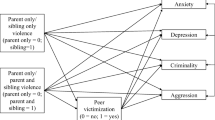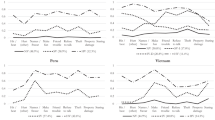Abstract
As children’s exposure to violence (EV) has become more evident, concern for the implications that violence has on children has risen. Consequently, researchers have explored the relationship between exposure and outcomes, as well as potential mediators and moderators. In this study, we (a) examined EV in a sample of children from the Midwestern United States; (b) replicated previous findings that identify a direct relationship between EV and psychological sequelae; and (c) explored the possibility that loneliness mediates the exposure–outcomes relationship. Children (11–14 years) in our sample were exposed to elevated levels of violence in their neighborhoods. Furthermore, children who were directly victimized demonstrated greater levels of behavioral difficulties than children who were not. Although loneliness was not a significant mediator, our findings have laid the groundwork for future research regarding the influence of peer relationships on EV and outcomes.

Similar content being viewed by others
References
Asher, S., & Wheeler, V. (1984). Children’s loneliness: A comparison of rejected and neglected peer status. Journal of Consulting and Clinical Psychology, 53, 500–505. doi:10.1037/0022-006X.53.4.500.
Baron, R., & Kenny, D. (1986). The moderator-mediator variable distinction in social psychological research: Conceptual, strategic, and statistical considerations. Journal of Personality and Social Psychology, 51, 1173–1182. doi:10.1037/0022-3514.51.6.1173.
Berman, S., Kurtines, W., Silverman, W., & Serafine, L. (1996). The impact of exposure to crime and violence on urban youth. The American Journal of Orthopsychiatry, 66, 329–336. doi:10.1037/h0080183.
Buckner, J., Beardslee, W., & Bassuk, E. (2004). Exposure to violence and low-income children’s mental health: Direct, moderated, and mediated relations. The American Journal of Orthopsychiatry, 74, 413–423. doi:10.1037/0002-9432.74.4.413.
Buka, S., Stichick, T., Birdthistle, I., & Earls, F. (2001). Youth exposure to violence: Prevalence, risk, and consequences. The American Journal of Orthopsychiatry, 71, 298–310. doi:10.1037/0002-9432.71.3.298.
Dempsey, M. (2002). Negative coping as a mediator in the relation between violence and outcomes: Inner-city African American youth. The American Journal of Orthopsychiatry, 72, 102–109. doi:10.1037/0002-9432.72.1.102.
Fitzpatrick, K., & Boldizar, J. (1993). The prevalence and consequences of exposure to violence among African-American youth. Journal of the American Academy of Child and Adolescent Psychiatry, 32, 424–430. doi:10.1097/00004583-199303000-00026.
Garbarino, J. (1995). Raising children in a socially toxic environment. San Francisco: Jossey-Bass.
Gladstein, J., Rusonis, E., & Heald, F. (1992). A comparison of inner-city and upper-middle class youths’ exposure to violence. The Journal of Adolescent Health, 13, 275–280. doi:10.1016/1054-139X(92)90159-9.
Hill, H., & Madhere, S. (1996). Exposure to community violence and African American children: A multi-dimensional model of risks and resources. Journal of Community Psychology, 24, 26–43. doi:10.1002/(SICI)1520-6629(199601)24:1<26::AID-JCOP3>3.0.CO;2-1.
Kansas City Police Department. (2006). Retrieved December 15, 2007, from http://www.kcpd.org/kcpd2004/a/Patrol%20Bureau%20Graph%20-%202007%203rd%20Quarter%20CSTAR.pdf.
Marans, S., Berkowitz, S., & Cohen, D. (1998). Police and mental health professionals: Collaborative responses to the impact of violence on children and families. Child and Adolescent Psychiatric Clinics of North America, 7, 635–651.
Margolin, G. (2005). Children’s exposure to violence: Exploring developmental pathways to diverse outcomes. Journal of Interpersonal Violence, 20, 72–81. doi:10.1177/0886260504268371.
Martinez, P., & Richters, J. (1993). The NIMH community violence project: II. Children’s distress symptoms associated with violence exposure. Psychiatry, 56, 22–35.
McCart, M., Smith, D., Saunders, B., Kilpatrick, D., Resnick, H., & Ruggiero, K. (2007). Do urban adolescents become desensitized to community violence? Data from a national survey. The American Journal of Orthopsychiatry, 77, 434–442. doi:10.1037/0002-9432.77.3.434.
Ng-Mak, D., Salzinger, S., Feldman, R., & Stueve, C. (2004). Pathological adaptation to community violence among inner-city youth. The American Journal of Orthopsychiatry, 74, 196–208. doi:10.1037/0002-9432.74.2.196.
Ozer, E., & McDonald, K. (2006). Exposure to violence and mental health among Chinese American urban adolescents. The Journal of Adolescent Health, 39, 73–79. doi:10.1016/j.jadohealth.2005.09.015.
Plybon, L., & Kliewer, W. (2001). Neighborhood types and externalizing behavior in urban school-aged children: Tests of direct, mediated, and moderated effects. Journal of Child and Family Studies, 10, 419–437. doi:10.1023/A:1016781611114.
Preacher, K., & Hayes, A. (2004). SPSS and SAS procedures for estimating indirect effects in simple mediation models. Behavior Research Methods, Instruments, & Computers, 36(Special Issue), 717–731.
Richters, J., & Martinez, P. (1990). Things I have seen and heard: A structured interview for assessing young children’s violence exposure. Washington D.C.: National Institute of Mental Health.
Richters, J., & Martinez, P. (1993). The NIMH community violence project: I. Children as victims of and witnesses to violence. Psychiatry, 56, 7–21.
Richters, J., & Saltzman, W. (1990). Survey of children’s exposure to community violence: Parent report. National Institute of Mental Health: Washington D.C.
Ruchkin, V., Henrich, C., Jones, S., Vermeiren, R., & Schwab-Stone, M. (2007). Violence exposure and psychopathology in urban youth: The mediating role of posttraumatic stress. Journal of Abnormal Child Psychology, 35, 578–593. doi:10.1007/s10802-007-9114-7.
Salzinger, S., Feldman, R., Stockhammer, T., & Hood, J. (2002). An ecological framework for understanding risk for exposure to community violence and the effects of exposure on children and adolescents. Aggression and Violent Behavior, 7, 423–451. doi:10.1016/S1359-1789(01)00078-7.
Storch, E., Phil, M., Nock, M., Masia-Warner, C., & Barlas, M. (2003). Peer victimization and social-psychological adjustment in Hispanic and African-American children. Journal of Child and Family Studies, 12, 439–452. doi:10.1023/A:1026016124091.
Storch, E., & Masia-Warner, C. (2004). The relationship of peer victimization to social anxiety and loneliness in adolescent females. Journal of Adolescence, 27, 351–362. doi:10.1016/j.adolescence.2004.03.003.
Thompson, R., Proctor, L., Weisbart, C., Lewis, T., English, D., Hussey, J., et al. (2007). Children’s self-report about exposure to violence: An examination of The Things I Have Seen and Heard Scale. The American Journal of Orthopsychiatry, 77, 454–466. doi:10.1037/0002-9432.77.3.454.
Wells, M., Burlingame, G., & Rose, P. (1999). Administration and scoring manual for the Y-OQTM-ST 2.0: Youth outcome questionnaire—Self report. Salt Lake City, UT: OQ Measures, LLC.
Author information
Authors and Affiliations
Corresponding author
Rights and permissions
About this article
Cite this article
Bender, J.A., Roberts, M.C. Exposure to Violence, Perceived Peer Relationships, and Corresponding Psychological Sequelae. J Child Fam Stud 18, 350–355 (2009). https://doi.org/10.1007/s10826-008-9237-7
Received:
Accepted:
Published:
Issue Date:
DOI: https://doi.org/10.1007/s10826-008-9237-7




